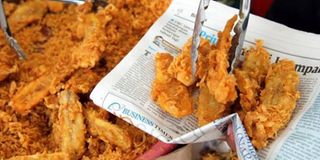Risks of eating out of newspapers

Newspapers are often used by food vendors to drain deep-fried foods but this exposes the consumers to health risks in the long run.
Newspapers are vital to the public as a source of news, information and for future reference.
However, newspapers can be a health hazard to people eating foods wrapped in them.
It is common practice to find many food vendors wrapping foodstuffs using newspapers and recycled paper inscribed with black carbon ink. Experts are warning that the practice is dangerous as it leads to cancerous diseases and must be stopped.
Prof Charles Muyanja, a specialist in Food Microbiology and the head of Food Safety at Makerere University Department of Food Science and Technology, says most inks used in newspaper printing are not “food grade.” “Food grade ink is made of reagents that are safe on foods and have no suspected health danger,” Muyanja says. “These may include inks used in stamps for meat certification in abattoirs,” he adds.
Muyanja observes that foodstuffs adulterated by newspaper ink raise a lot of health concerns since the ink contains “multiple bioactive” materials with known negative health effects. He says research has shown newspaper ink contains amoratic hydrocarbons and naphthylamine. “These chemical reagents,” the Makerere don says, “are suspected to cause lung and bladder cancer among people with long term exposure to newspaper inks.”
Mr David Ssali, a nutritionist, says the type of materials used to manufacture newspapers are medically unhealthy. Newspapers being made out of recycled materials, it becomes easy for the greasy food to absorb the black carbon ink chemical ingredients due to direct contact.
“Prevention is better than cure. Rather than waiting to contract diseases in the long term, it is good practice to avoid the habit because it costs nothing to use safer options of food wrappers,” Ssali advises. He adds that the manner in which newspapers are handled also raises many health questions. “The number of hands they go through to reach the person using them as foodstuff packages is enough to cause health concerns,” says Ssali.
Dr Hajjirah Kataike, a general practitioner at Kibuli Hospital, says with the typhoid outbreak hitting hard in Kampala, newspapers are potential agents of the typhoid-causing salmonella bacteria. She advises that it is good practice for people to carry their own food carriers, where they can safely keep their snacks which must be bought hot.
Prof Muyanja notes that with the increase in unregulated small foods and snacks producers operating in the confines of their houses and stores, other risky practices such as using newspapers as cooking oils absorbents, occur silently.
The practice of wrapping foodstuffs in newspapers is common with roadside food vendors dealing in deep-fried snacks. While there are some people who use newspapers cuttings as drug pouches or envelopes, Prof Muyanja says for drugs, the risks of contamination are minimal. He says the risk arises from the source of origin where they have been stored and also from the handlers.




